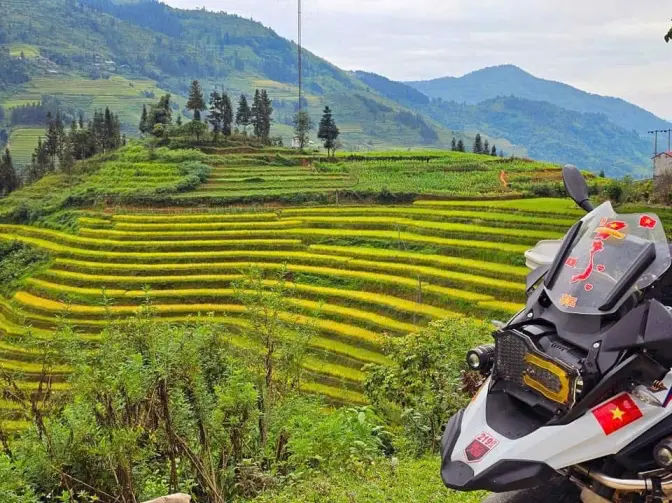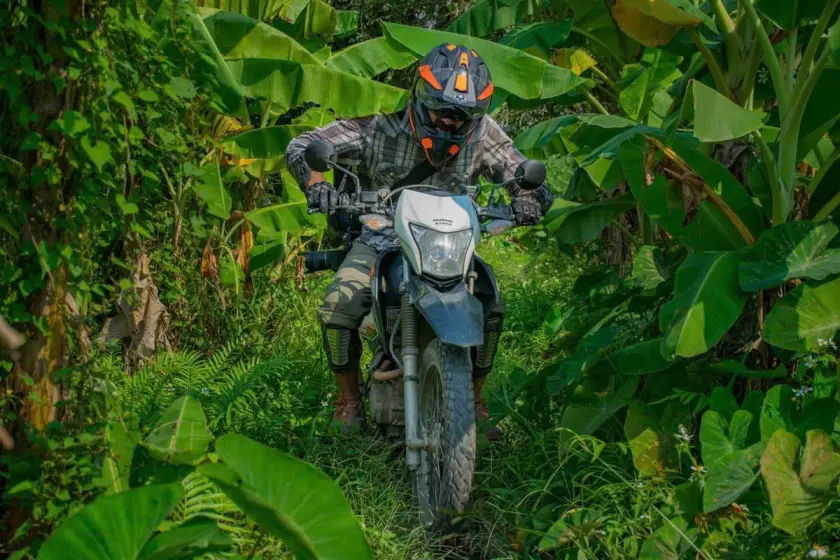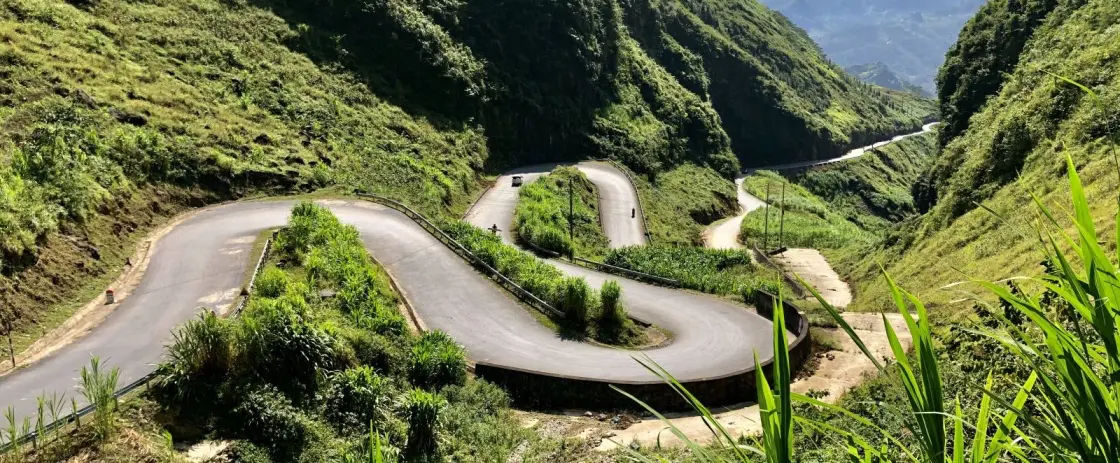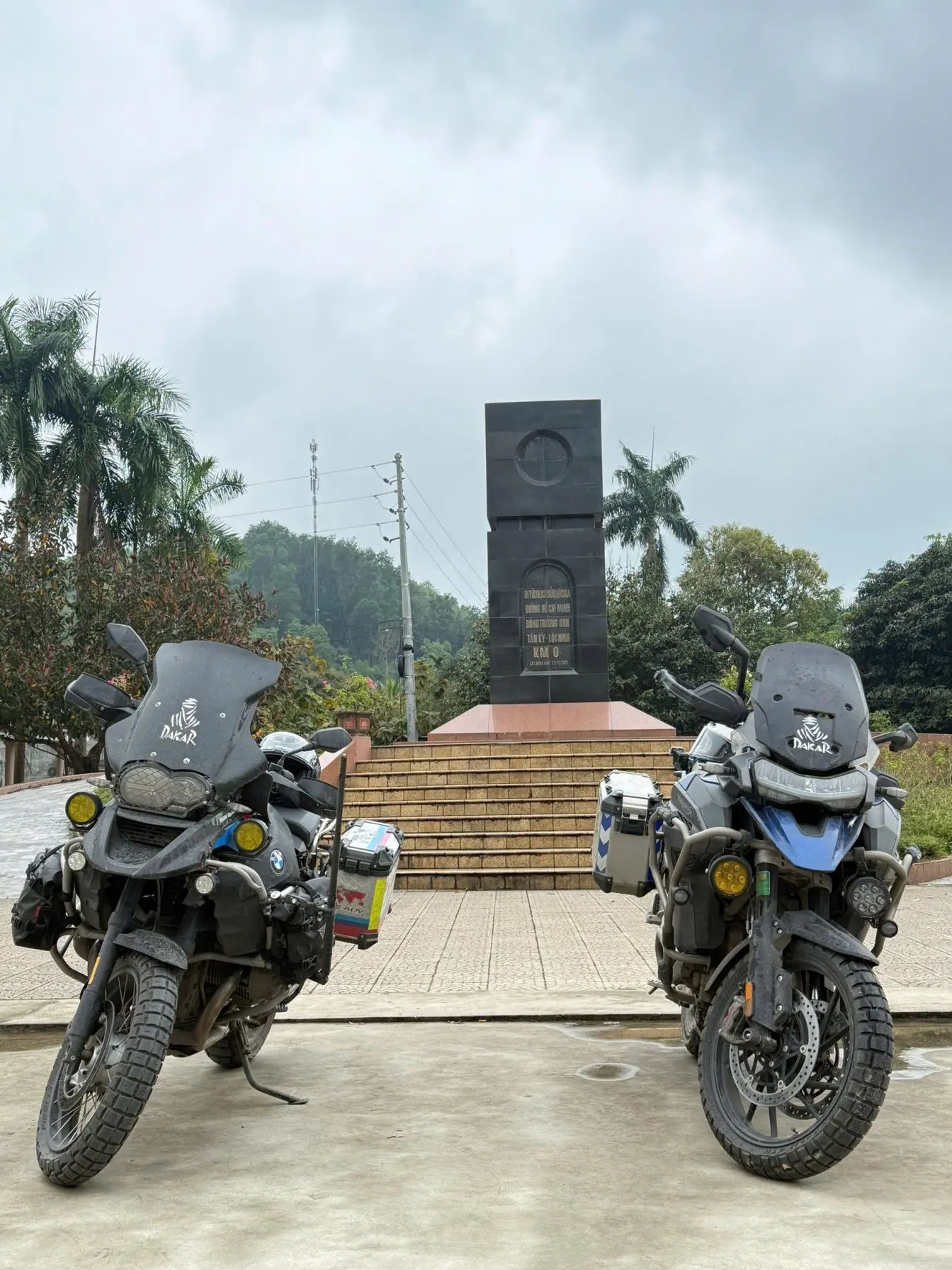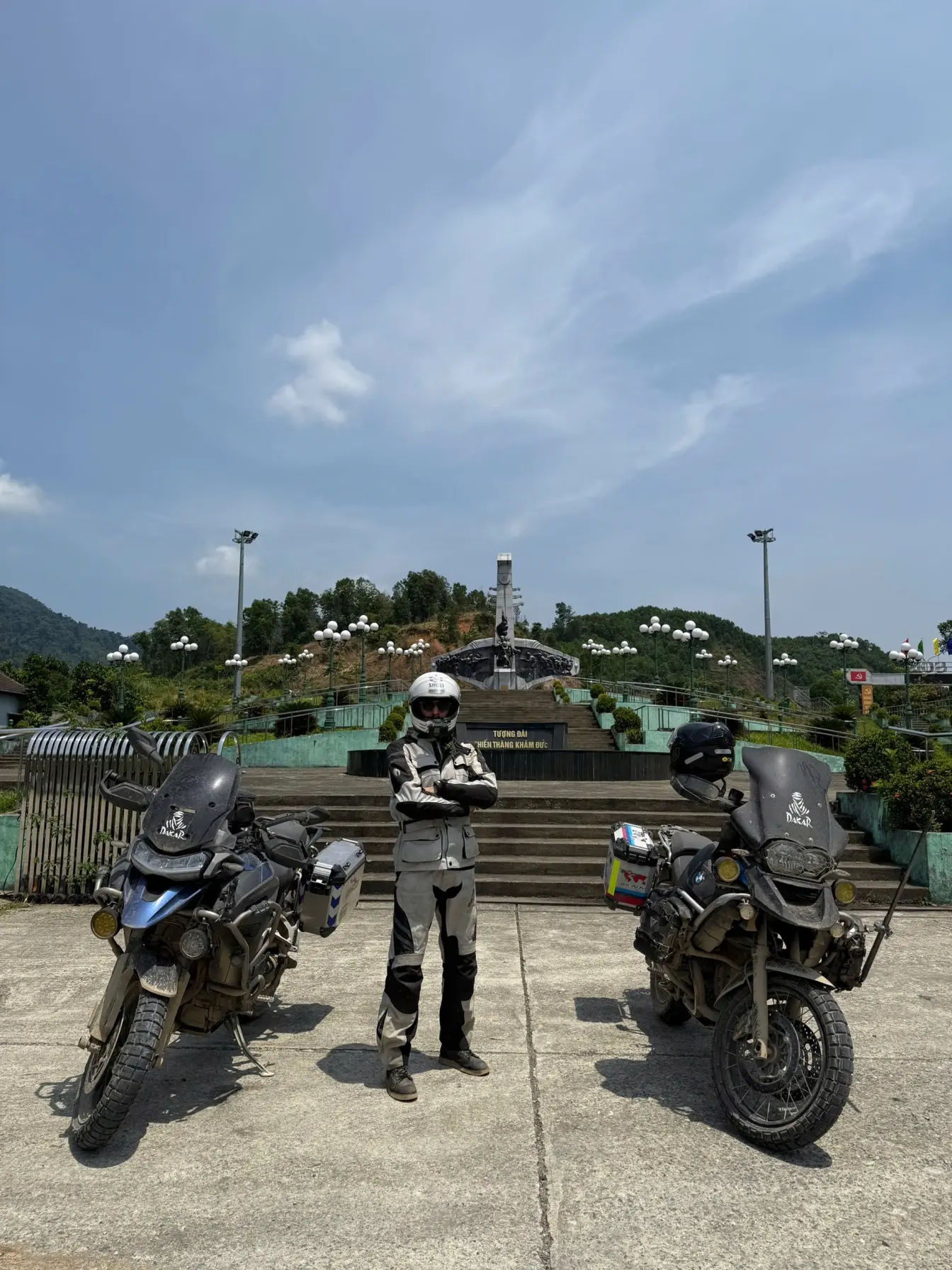
Ha Giang or Cao Bang Loop? We often hear this question by the riders, they want the best, but the reality is, both loops promise wow landscapes, but the experience you want, fro riding to the vibe, thrill or tranquility, will decide which road you take.
Let’s simplify it, Hà Giang is the wilder ride, full of sharp turns, dramatic passes, and epic views that make every twist of the throttle feel like an adventure movie. Meanwhile, Cao Bang gives off a calmer, more laid-back vibe. Check out best motorbike tours in Vietnam
In this post, I simply share my own prospective and comparing Cao Bang and the Ha Giang, the simple answer is, if you’re thinking about Hà Giang being too crowded, Cao Bằng is an alternative loop being less traveled and totally different on what things to experience, let’s dive into this.
Ha Giang vs Cao Bang: Which is better?
Hard to say which is better since both offer amazing landscapes. The two stars of this adventure are the Hà Giang Loop and the Cao Bằng Loop, each offering a unique vibe. Hà Giang delivers heart-racing turns, dramatic cliffs, and that pure adrenaline rush riders crave. Cao Bằng, on the other hand, offers a calmer journey — smoother roads, easier access from Hanoi, and iconic stops like Ban Gioc Waterfall, making it ideal for travelers who prefer relaxed sightseeing mixed with authentic countryside experiences.
Motorbiking through northern Vietnam is one of the most do travel experiences I advise to anyone visiting Vietnam. If you’re into adventure on a big bike, you can imagine cruising along rugged mountain passes, the air crisp, the scenery endless limestone peaks, misty valleys, and winding roads that make you feel like you’re riding through a travel documentary.
Which one other riders prefers?
This is a general disclaimer, but based on real travelers, riding forums, and our local experience, the main difference is intensity. Hà Giang is for thrill-seekers who love challenging terrain and steep mountain passes. Riders often warn about sharp turns, narrow cliff roads, and unpredictable weather. It is breathtaking, but it demands skill, focus, and a sense of adventure.
Meanwhile, Cao Bằng is the under-the-radar gem that many describe as friendlier, less crowded, and rich in variety. Expect rolling hills, local homestays, and spontaneous tea breaks with curious villagers. Many experienced bikers even recommend combining both loops for the perfect mix of excitement and tranquility.
Both routes reward preparation: a reliable 150cc enduro off-road motorbike, offline maps and a sense of adventure. Ride during spring or autumn for clear skies and dry roads, and take your time, the journey is as rewarding as the destination. Whether you’re chasing hairpin thrills on the Hà Giang Loop or exploring the peaceful waterfalls and valleys of Cao Bằng, each loop showcases the soul of northern Vietnam, breathtaking landscapes, open-road freedom, and the warmth of local life that stays with you long after the ride ends.
Overview of Hà Giang Route
Geography and Key Highlights
The Hà Giang sits at Vietnam’s northernmost tip, where roads twist through limestone karsts and cloud-hugged mountain passes that feel like they belong in another world.
The loop typically starts in Hà Giang City, then runs through Quan Ba, Yên Minh, Đồng Văn, and Mèo Vạc, forming a rugged circuit that borders China’s Yunnan province. Imagine riding up the Heaven’s Gate Pass (Quan Ba Pass) as morning mist curls over terraced hills, or standing at the Lũng Cú Flag Tower, where you can literally see the Chinese border.
The Đồng Văn Karst Plateau, a UNESCO Global Geopark, is another highlight, a surreal landscape of grey rock mountains and tiny H’mong villages. Then comes the crown jewel of adventure: Mã Pí Lèng Pass, a serpentine road perched above a gorge so deep it takes your breath away. Every turn feels like a cinematic drone shot.
- Check out the alternatives to classic Ha Gian Loop
Road Conditions and Popular Stops
Additionally, roads vary from smooth asphalt near towns to rough, narrow stretches carved into cliffs. Sections like Mã Pí Lèng and Đồng Văn to Mèo Vạc can get tricky after rain, with sharp bends and loose gravel. Locals and riders often recommend doing the loop counterclockwise for better views and safer climbs. Popular stops include Lũng Cú Flag Tower, Đồng Văn Old Quarter, Mã Pí Lèng Skywalk, Du Già Village (known for cozy homestays and waterfalls), and the Nho Quế River viewpoint, where you can take a boat through jade-green waters beneath towering cliffs.
Expect occasional roadworks, water crossings, and spontaneous buffalo traffic jams, part of the Hà Giang charm that makes you smile under your helmet.
Overview of Cao Bang Route
The Cao Bằng is geographically located on the northeast of Hanoi, some 6 hours ride, is a calmer, more scenic alternative to Hà Giang, a relaxed ride through rolling hills, emerald valleys, and quiet ethnic villages.
Starting from Cao Bằng City, the route winds through Trùng Khánh, Nguyên Bình, and Quảng Uyên, passing Tay and Nung hamlets like Phong Nam, Khuổi Ky, and Ban Gioc.
Highlights include the majestic Ban Gioc Waterfall on the Chinese border, the crystal Thang Hen Lake cluster, and the vast Nguom Ngao Cave filled with glowing stalactites.
The landscape is softer here, farmland, bamboo groves, and stilt houses set against karst peaks. Roads are smoother and wider than Hà Giang’s, with QL3 and QL34 offering easy access from Hanoi, and scenic routes like DT206 to Ban Gioc and DT212 through Trùng Khánh providing some of Vietnam’s most rewarding rides.
Stops like Phia Oắc , Phia Đén National Park and Nguyên Bình’s mountain villages showcase untouched northern charm, while cozy homestays in Quảng Uyên or Khuổi Ky invite travelers to share corn wine and grilled stream fish. Most of the loop is paved, with only short dirt stretches, just enough to keep it adventurous without the stress.
Comparing Hà Giang and Cao Bằng Routes
Scenery and beautiful landscapes
Okay, here I am comparing the routes, first things first, both locations are offering northern mountain passes, Hà Giang routes are wilder, unpredictable, and cinematic, while routes to Cao Bang (From Bac Kan and Ba Be), would be the slow, scenic montage that makes you fall quietly in love with the countryside.
The Hà Giang is more of a jagged limestone peaks and narrow granite mountain passes that hang above deep valleys. Riding the QL4C highway between Đồng Văn and Mèo Vạc feels like flying through a stone kingdom, with the Mã Pí Lèng Pass offering one of the most iconic views in Vietnam. Villages like Lũng Cú, Du Già, and Yên Minh blend rustic charm with heart-stopping landscapes.
Cao Bang, by contrast, unfolds gently. The DT206 road leading to Ban Gioc Waterfall passes green valleys, bamboo forests, and fields dotted with Tay and Nung villages. The Trùng Khánh and Nguyên Bình areas reveal a side of northern Vietnam that’s quieter and more soulful. Instead of endless switchbacks, you get shimmering lakes like Thang Hen, ancient limestone caves like Nguom Ngao, and slow rivers reflecting the karst peaks. If Hà Giang is for those chasing mountain highs, Cao Bằng is for travelers who want to stop, breathe, and soak in the peace. Check the map out;
Difficulty and Road Conditions
he roads aren’t difficult per say (for those with some riding skills), the QL4C and Mã Pí Lèng Pass are steep, narrow, and full of blind corners that test both nerves and skill. Weather adds another layer, fog, drizzle, or loose gravel can turn an ordinary curve into a heart-stopping slide. It’s not dangerous if you go slow, but you do need focus. Locals and veteran riders often recommend a semi-automatic or manual 150cc+ motorbike, sturdy tires, and no night riding. If you’re a first-timer, join a Ha giang motorbike tours with local guide, they know where to slow down, stop for drone-worthy photos, and where the best pho and petrol spots are.
Cao Bang’s roads, on the other hand, are smoother and match more with begginers. The QL3 highway from Hanoi to Cao Bang is well-paved, and once you branch onto DT206 or DT212, the ride becomes relaxed and scenic.
You’ll still find occasional gravel patches or rural detours, especially near Nguyên Bình or Phia Oắc – Phia Đén National Park, but nothing extreme. It’s ideal for intermediate riders who want adventure without white-knuckle moments. Many travelers describe Cao Bằng as a “confidence builder” , less pressure, more enjoyment, and plenty of chances to stop for drone shots or chats with locals tending buffalo in the fields. Watch the video, riding toward Cao Bang and Ban Gioc;
Accommodation and Local Services
In Ha Giang, tourism has grown faster (simply because we tourist make it more popular), and it shows in the range of stays from small lodges to 4 star comfortable hotels, smaller areas such as hostels in Đồng Văn Old Quarter offer lively backpacker stays to peaceful homestays in Du Già Village or Yên Minh.
Expect simple rooms, home-cooked meals, and shared rice wine sessions that stretch into the night. Fuel stations are scattered along the main loop, though smaller villages may rely on bottled petrol. Mechanics are easy to find in Đồng Văn, Mèo Vạc, and Hà Giang City.
Hotels, or homestays in Cao Bang are around the more local experience. The guesthouses in Trùng Khánh and Quảng Uyên often double as family homes. You’ll be invited to eat sticky rice, drink corn wine, and share stories by the fire.
If you plan to stay near Ban Gioc Waterfall, there are a few small homestays. In addition, there is a larger resort right next to the waterfall, with rooms overlooking the cascade.
Phia Đén Eco-Lodge near Nguyên Bình and lakeside homestays near Thang Hen provide a cozy escape surrounded by karst peaks. Services are improving but remain modest, ATMs can be scarce, and restaurants close early, so plan your meals ahead.
Tips for Motorbiking in along the Cao Bang to Ha Giang
I ride these area, the roads along Cao Bang to Ha Giang since 2009 and each time I think of having a different ride. I share my own tips and advices and hopefully you’ll find it useful.
Choosing the Right Motorbike
Choosing the right bike can make or break your northern frontier adventure. For the winding roads of Hà Giang and Cao Bằng, most seasoned riders suggests any manual bike, bit since I am into big motorbike side, then I suggest at least a 150cc motorbike and models like the Honda XR150, CRF250, or CB500X, that handle mountain passes far better than smaller scooters.
On rougher stretches like the Mã Pí Lèng Pass (QL4C) or the rural DT212 through Trùng Khánh, you’ll want good suspension and tires with grip. If you’re new to riding, consider joining a tour, or spend more time to plan the route and choose teh bike more carefully.
Safety Tips and Gear Essentials
Take this serious, specially if you’re riding on rainy season (summer), and or drizzling winter. Riding in northern areas isn’t dangerous, it’s just unpredictable.
Weather shifts quickly, from sunshine to fog to sudden drizzle, especially in Hà Giang’s high passes or Cao Bằng’s hill valleys. Slow down on wet corners and watch out for unexpected guests: buffaloes, kids, or chickens crossing without warning. Locals often say, “Don’t fight the mountain; flow with it.” That mindset keeps you safe. Never ride after dark — the roads lack lighting, and mist can blanket everything after sunset.
Your gear is your safety net. A full-face helmet, riding gloves, ankle boots, and a windproof jacket are essential, even in warm months.
Riders often share stories of simple mishaps, a flat tire on DT206 near Ban Gioc, or sliding on gravel between Yên Minh and Đồng Văn, that turned into unforgettable memories because locals rushed out to help. Respect the road, take it slow, and remember: the goal isn’t just to reach the next town, but to enjoy every kilometer of mountain air and quiet beauty along the way.
Best Seasons to Travel Cao Bang & Ha Giang
Both Ha Giang and Cao Bang transform beautifully with the seasons, each offering a distinct riding experience depending on when you go. The best time to explore either loop is spring (March–May) or autumn (September–November), when skies are clear, temperatures are mild, and the landscapes are at their most photogenic.
In Ha Giang, spring brings peach and buckwheat blossoms around Yên Minh and Đồng Văn, while Cao Bằng glows with fresh greenery and calm blue lakes. By autumn, Hà Giang’s terraced fields near Du Già turn golden, and Cao Bằng’s valleys around Trùng Khánh shimmer in harvest colors beneath clear, dry skies, perfect for smooth rides on roads like QL4C and DT206.
- Check out best months to go to Ha Giang
Summer (June–August) brings vivid green scenery but also sudden downpours and slippery mud, especially on Hà Giang’s steep passes like Mã Pí Lèng. Cao Bằng, with its gentler roads, handles the rain a bit better but still demands caution.
Winter (December–February) can be cold and misty. Hà Giang’s high peaks and Cao Bằng’s Phia Oắc area are often blanketed in fog. It can feel eerie, yet enchanting for those who don’t mind the chill.
FAQs: Ha Giang vs Cao Bang
Which route, Hà Giang or Cao Bằng, offers more scenic landscapes?
Hà Giang is more dramatic, with rugged mountains and steep passes and more touristy. Cao Bằng is softer and greener, featuring waterfalls, lakes, and peaceful valleys and less touristy.
How many days should I allocate for each route?
Ha Giang: 3–4 days for the full loop. Cao Bang: 2–3 days to explore main highlights like Ban Gioc Waterfall and Thang Hen Lake. Both locations can be extended to few more days to ride roads less known.
What type of motorbike is best for both Ha Giang & Cao Bang?
Ha Giang: Adventure or dual-sport bikes in the 250–400cc range, such as Honda CRF250L, Kawasaki KLX300, or Yamaha Tenere, are ideal. They handle steep, rough roads and long mountain passes with ease.
Cao Bang: Bikes in the 200–500cc range, like Honda CRF300L, Suzuki V-Strom 250/650, or Yamaha Tenere 700, work well. The smoother roads are easy to ride, and they have enough power for occasional dirt sections
Are there enough accommodation and food options along both routes?
Yes. Hà Giang has a wide range of homestays and guesthouses. There are also larger hotels with better food options in towns like Đồng Văn and Du Già. Cao Bằng offers cozy local stays in Trùng Khánh and Quảng Uyên with plenty of family-run small eateries.
Which route is more suitable for beginners or less experienced riders?
Cao Bang is better for beginners with easier roads, lighter traffic, and a relaxed pace. Ha Giang in the other hand, suits confident riders comfortable with sharp turns and mountain terrain.
Conclusion: Cao Bang vs Ha Giang Loop: Which one did I prefer?
Choosing between the Hà Giang and Cao Bằng Loops isn’t about which is better. I may like one, you may prefer the other — it depends on what kind of adventure calls you. Hà Giang is wild, raw, and heart-thumping. Every corner of Mã Pí Lèng Pass makes you catch your breath.
Cao Bằng, in contrast, moves slower and softer. It is a land of waterfalls, lakes, and mountain villages, where the ride feels like meditation on wheels. Both loops reveal the untamed soul of northern Vietnam. Limestone peaks rise like ancient guardians, roads wind past rice fields, and smiles from villagers make every stop unforgettable.
About the Author
Hamid is a passionate adventurer and off-road enthusiast who has explored rivers, mountains, and remote trails across northern Vietnam. Always chasing the thrill of motorbike journeys and hidden landscapes, he shares firsthand experiences to help travelers ride smarter and see more.



